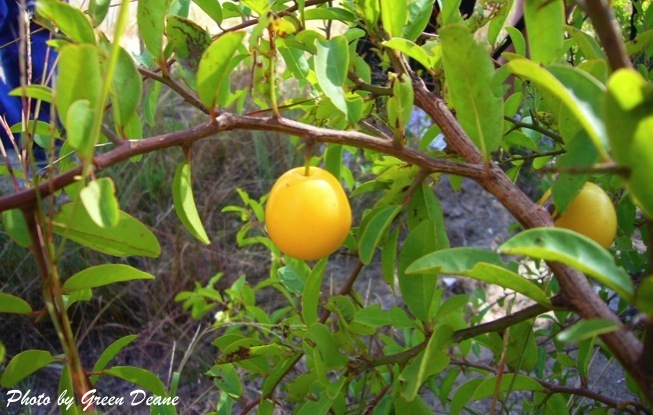
A perfectly ripe tallow plum. Photo by Green Deane
It was mostly a yellow weekend… Tallow Plums, bright yellow when ripe, were in abundance, many waterways are bright with Yellow American lotus, Mahoes are starting to blossom, which are first yellow and later red, Goldenrods are blossoming, and Maypops are fruiting, which turn yellow when ripe.
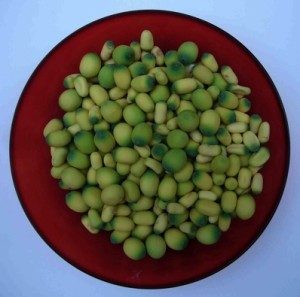
American lotus seeds ready for cooking. Photo by Green Deane
Tallow Plums when ripening turn from green to a bright yellow, then darken some as they add sugar and sweeten. American Lotus seeds are perhaps the best long term storage food in North America. They can remain viable for 400 years. A fully ripe seed has a small plant inside it that is bitter. I boil the seeds like peanuts in the shell, open, split the seed, remove the green part then eat, with some salt. They are not like boiled peanuts but that is the closest comparison. The seeds are far more easy to collect than the edible roots, which are always buried deep in lake or river mud and a long ways from the plant. The one advantage of cultivating this plant is controlling where the root will be.
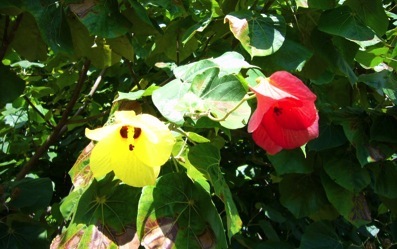
Edible Mahoe blossoms. Photo by Green Deane
The mahoe is in the hibiscus group and has many edible parts, blossoms, leaves, cambium, and young roots. Blossoms are yellow when they open and if they don’t get pollenated they turn deep red. It’s relative, the seaside mahoe, also has edible blossoms and leaves. Unfortunately both species like to be within about 15 miles of the coast in warmer area, so I see them often in south Florida, the mahoe inland, the seaside on the beach. Blossoms are edible raw or cooked.
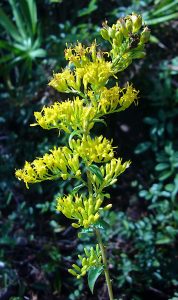
Goldenrod is ruderal. What does that mean? Read the article. Photo by Green Deane
In blossom now and seen last week at Gainesville is Goldenrod. It is a bit of a treasure hunt and disappointment. The treasure hunt is that one species is better than all the rest for tea, Solidago odora. It does grow here, has an anise flavor, but is hard to find. It’s reported in most counties but is not common. Goldenrod grows in about half of the United States, southwest to northeast. Other Goldenrod species can also be made into tea, perhaps all of them particularly for herbal applications, but they don’t taste anywhere near as good as the Anise one. In fact, after the “Boston Tea Party” of 1773 halted tea imports colonialists drank Goldenrod tea and even exported some to China. It did not catch on. However, every time I see a Goldenrod I pull off a leaf and crush it hoping to detect the tell-tale anise smell. It’s a golden treasure hunt.
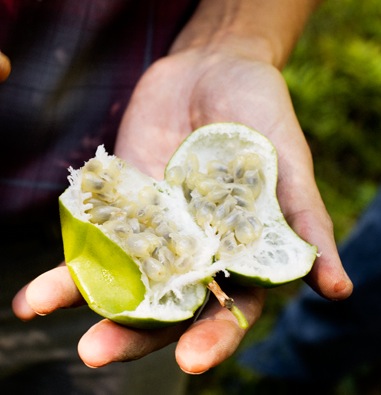
A almost ripe Maypop. Photo by Green Deane
One last palatable yellow edible is the Maypop, Passiflora incarnata. One rarely find the ripe yellow fruit because many woodland creatures like them. We saw several green ones in Gaineville this past weekend. The green fruit has two stages. Green with plain-tasting seeds inside, then later with sweet and sour seeds inside, lastly then yellow with sweet and sour seeds. If the yellow ones are not eaten they either dihydrate or rot on the ground. One can eat a little of the green fruit raw, or cook them like a green tomato. The yellow ones can be eaten raw in moderation. The cooked leaves — which smell like a rubber gym shoe — can also be eaten and have a calming effect caused by their GABA content, Gamma aminobutyric acid.
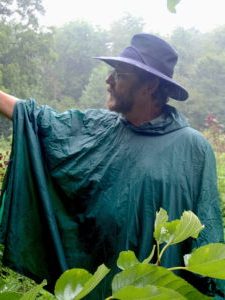
Classes are held rain or shine or cold. (Hurricanes are an exception.) Photo by Kelly Fagan.
Foraging Classes. On the west side of Florida this weekend:
Saturday, August 13th, John Chestnut County Park: 2200 East Lake Road, Palm Harbor, FL 34685. Meet at the trail head of the Peggy Park Nature Walk, pavilion 1 parking lot. 9 a.m.
Sunday, August 14th, Bayshore Live Oak Park, Bayshore Drive. Port Charlotte, meet at the parking lot at Bayshore and Ganyard Street. 9 a.m.
Saturday, August 20th, Mead Garden: 1500 S. Denning Dr., Winter Park, FL 32789. Meet at the bathrooms. 9 a.m.
Sunday, August 21st, Florida State College, south campus, 11901 Beach Blvd., Jacksonville, 32246. We meet at Building A next to the administration parking lot. 9 a.m.
For more information, the pre-pay for a class, or sign up go here.
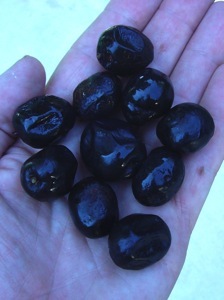
Eating Saw Palmetto fruit is a challenge.
Also turning yellow this month but far less palatable are Saw Palmetto berries. This month they usually change from green to golden and by September from gold to black. That’s when they are at their best and taste like vomit. Dehydrating them or soaking in vodka does not improve them much, but they have all the essential amino acids we need so they are good for you, you just have to learn to tolerate the flavor… like an intense blue cheese with at lot of hot pepper. Find them soon or the poaching industry will take them. One thing I have never tried and our readers who are chefs might, is using them for flavoring. Their initial flavor is intense and sweet. I will dry some this year for powdering, maybe mix with salt.

You get the USB, not the key.
Changing foraging videos: As my WordPress pages are being updated the video set will go away. They are the same videos I have on You Tube. Some people like to have a separate copy. The DVD format, however, is becoming outdated. Those 135 videos plus 36 more are now available on a USB drive. While the videos were played from the DVDs the videos on the USB have to be copied to your computer to play. They are MP4 files. The 171-video USB is $99. If you make a $99 “donation” using the link at the bottom of this page or here, that order form provides me with your address, the amount — $99 — tells me it is not a donation and is for the USB.

Green Deane Forum
Want to identify a plant? Perhaps you’re looking for a foraging reference? You might have a UFO, an Unidentified Flowering Object, you want identified. On the Green Deane Forum we — including Green Deane and others from around the world — chat about foraging all year. And it’s not just about warm-weather plants or just North American flora. Many nations share common weeds so there’s a lot to talk. There’s also more than weeds. The reference section has information for foraging around the world. There are also articles on food preservation, and forgotten skills from making bows to fermenting food.
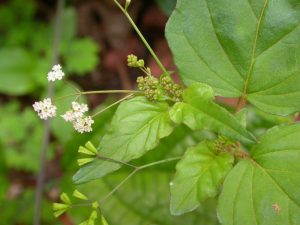
Boerhavia erecta. Photo by Green Deane
As mentioned above foraging is like treasure hunting. While pedaling once in Apopka I had to stop at an intersection and noticed some Boerhavia diffusa. It’s a common barely edible probably from India or near there. One usually finds it in somewhat trashy ground such as sidewalk cracks, parking lots, and dumps. So when I stopped at the intersection it was no surprise to see Boerhavia growing there. But growing next to it was a white Boerhavia. That I had never seen. And the leaves were more pointed than the common species. A little bit of research suggests I found B. erecta, which surprisingly is a Florida native. It has spread to other parts of the world, however, and is reportedly edible and medicinal like B. difussa. After a bit more research I might have to update my article on the species. Until then you can read about the ruby-blossomed B. diffusa here.
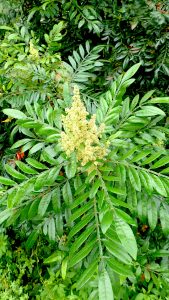
Sumacs are in blossom. Photo by Green Deane
What is that? It’s a common question locally now that sumacs are in bloom. Their creamy terminal blossoms stand out looking somewhat exotic among the dark green foliage. The most common species here is Winged Sumac which is also one of the most widely-distributed sumac in North America. It’s found nearly everywhere though in different locales other species may dominate. Where I grew up in Maine Staghorn Sumac was the common species and grew quite tall. I see them often when I visit North Carolina. The key to making sure you have an edible sumac and not toxic Poison Sumac or Brazilian Pepper is location of the blossom and subsequent fruit. Edible sumacs have terminal clusters of medium to dark red berries covered with fine hair. In this case “terminal” means they are on the very end of the branch, like the blossom on the left. Brazilian Pepper has pink berries that are further down the branch. Poison Sumac, which only grows only in wet places, has dull cream to green-cream berries also further down on the stem. To read more about sumacs go here.
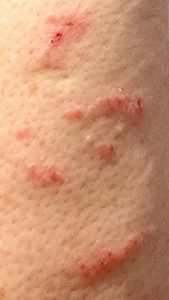
Poison ivy is itchy and lasts or days.
Me and Poison Ivy. My mother was highly resistant to it. I am not. In fact it is quite predictable. Get exposed Sunday Morning, I will have skin eruptions Tuesday morning, some 48 hours later. In our foraging class in Gaineville Sunday I dug up some winged yams among poison Ivy. As there was no detergent and water around I used hand sanitizer on exposed parts. I feel lucky to only have it on my right hand and wrist. Think of poison ivy oil as an invisible bike chain grease. It requires more than washing but rubbing off as well. Current thinking is everyone is born with a certain amount of resistance to it and each exposure reduces that resistance. Folks who think they are immune are the ones who usually end up in the hospital with it because they don’t avoid poison ivy. What the oil does is make proteins in live skin cells sticky, and then the body can’t communicate with the stuck cells thus chooses to get rid of them. I once got poison ivy from the feathers of a duck. (You can also get it from pet fur.) Only humans, some primates and guinea pigs get poison ivy.
This is weekly newsletter #519, If you want to subscribe to this free newsletter you can find the sign-up form in the menu at the top of the page.
To donate to the Green Deane Newsletter click here.


Thank you for your newsletter. Can you tell me if river oats are edible and, if so, how can I process them to separate the husks from the tiny seeds. I have a stand under my mulberry tree and would love to see something from them other than their beauty and use as a chipmunk refuge. I would be happy to share some if you want them. Again, thank you for your informative newsletter.
Is false nettle Boehmeria cylindrica edible?
Will you tell us some more about your upcoming book?